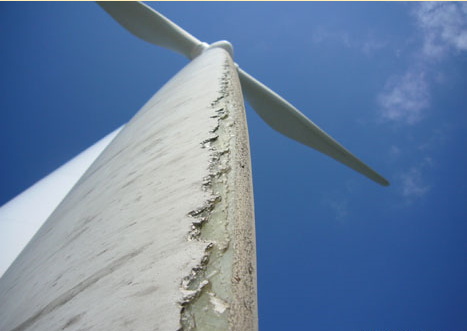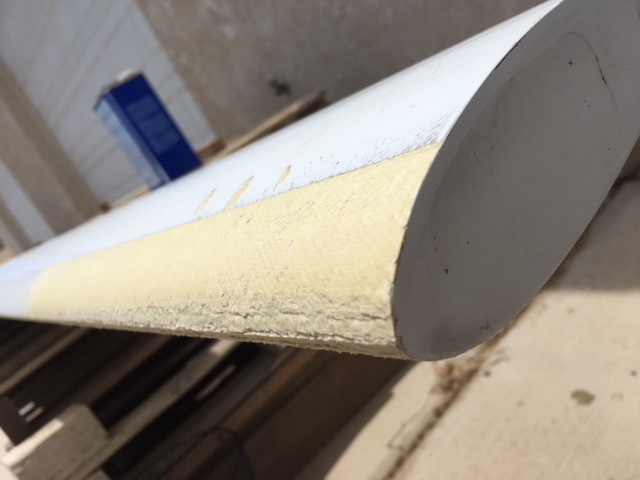This conversation made me curious about leading edge erosion of aluminum wings. As pointed out, the speed of jetliners is so much faster than most wind turbine blades, we might expect more erosion. Well, I did find this link to an article about the degradation of leading-edge inflatable neoprene wing de-icing boots:
https://www.aviationpros.com/aircraft/business-general-aviation/article/12341137/deice-boot-maintenance-101-the-why-and-how-of-pneumatic-deice-boot-care-and-repair
Turns out ozone and static electricity buildup are the main culprits.
Regarding erosion from dust: I’ve had hang-glider and paraglider pilots come down from a mile or two in the air in a notorious dust-devil area called Lucerne Valley in California where a series of nonstop huge dust-devils blows through like a freight train during 100-degree+ sunny days in summer. Dry lake beds provide the dust. The dust-devils are also thermals that the pilots can ride upward. They come down with dirt in their teeth and complain about sand and gravel in the air way up there.
With regard to erosion of aluminum leading edge surfaces, I’m not specifically aware of a problem with that per se, although it may exist since aluminum is a rather soft metal. The reason aluminum has never worked out for wind turbine blades, from what I’ve heard anyway. is metal fatigue, in a structural sense.
I know there have been some very large early experimental wind turbines using aircraft-technology-based aluminum blades, but that choice of blade materials did not catch on, with wood/fiberglass becoming the material of choice. Not sure why there is not more in the way of metal leading edges, but there are several factors that may be relevant. One could be a conflict with the coefficient of thermal expansion of various materials - if the metal expands more than fiberglass, it could cause detachment on hot days for example. Also, any imbalance in the rotor from a detached component could damage the turbine. How to attach such a protective leading edge sheath might also be a problem - if water gets behind it and freezes, it might cause issues. Weight might be a factor. Maybe aerodynamic performance could be degraded by the interface between composite and metal.
I do know of one brand that did add metal strips for turbines on islands in the North Sea where the leading edge tape (soft) would start detaching after just a couple of months. The metal strips are screwed on and are now an option with additional cost. That is the same 10 kW model we have at our facility. It is the most well-known 10 kW turbine, but the engineering is lacking, made up for by building it way stronger than it should need to be.
One of many problems with this model is inadequate overspeed protection. They are supposed to furl sideways to control output in strong winds, but instead they tend to first go into a very noisy overspeed phase. Next, the inverter is forced to “let go” of the turbine, which is at that point producing more power than the inverter can handle. So then the turbine is running unloaded and therefore spins even faster, often sounding like a huge helicopter or freight train. At that point, running way faster than it should, it finally develops enough thrust force to furl sideways. But it furls too far, going all the way sideways. At that point the rotor is no longer aimed toward the oncoming wind at all, so it slows to a crawl. The turbine comes almost to a stop, so then, with ~zero thrust loading, it swings back into the wind (facing the wind). But the grid regulations dictate that the inverter go through a five-minute sequence to reconnect to the grid, so the turbine immediately accelerates back up to overspeed, with the blades traveling over 200 MPH, still unloaded. This cycle endlessly repeats until either the storm passes, or the turbine explodes, throwing a blade. We often see this model with missing blades. In one case a blade was thrown over 700 feet. We have one with just a single blade left about a mile from here right now.
There is a manual furling cable that allows you to manually furl the turbine from the base of the tower by turning a hand-winch. But this feature was only added to make some certifying agency happy, and the cables always break, due to a very poor choice of attachment point on the tail, whereby the cable has insufficient leverage compared to its insufficient strength.
So on the one hand, dealers recommend manually furling the turbine when a storm approaches, but on the other hand, you can only do this a few times before the cable breaks. They all break eventually, and the tech support will tell you to just forget about the cable. They can sell you a new one, but it will break just like the last one - a waste of time and money to bother replacing it. Even just fixing a loose edge on leading edge tape costs well over $1000 since the installers need to call in a crane. To fix a piece of tape…
This is the “best” small wind turbine in the world and it is a piece of crap with so many interdependent failure modes that it is only a matter of time til it fails, yet all the standards are written around its flaws because without this under-engineered yet over-built model, there is pretty much no choice out there. The certifying bureaucrats had to allow one model to be certified, or they would be out of a job. It is that simple.
Any other brand is even worse, in some other way. So the state of “small wind” these days is almost a lost cause in light of solar having become so cheap. I see a great opportunity for someone to develop a reliable, affordable small wind product, but so far, nobody has. A decent turbine will be fine in 20 mph winds, but when you get up to 30 mph and above, they all tend to fail long before blade erosion becomes an issue.
One huge problem is the fact that any model requires years of continuous operation in many challenging high-wind locations, before the problems become identifiable. And the recent thrust toward “certification” makes it worse, since it requires a defined model that does not change, and the certification must be paid for so the manufacturer is locked in to whatever bad design they started with.
The whole thing has became a joke, once enough bureaucracies became involved. It is not a happy story. But it could an endless open opportunity if anyone could sufficiently improve the technology to make it as cheap and reliable as solar…


